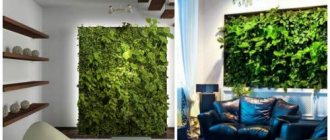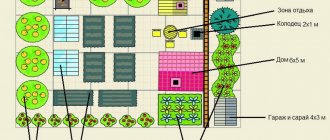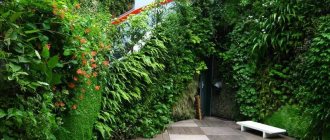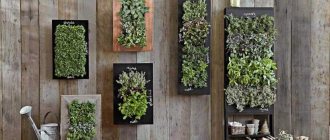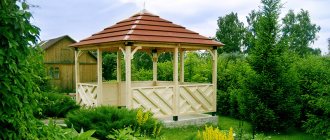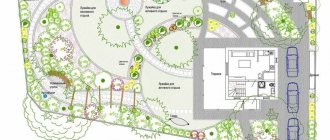Responsibilities of Vertical Gardening
Do-it-yourself landscaping will help hide surfaces or structures that are not entirely aesthetic. It can even turn a shed with hoes into a cozy place, decorate a somewhat dilapidated wall, giving it the effect of an ancient castle with a sleeping princess inside or a charming house of forest elves.
Such a vertical flower bed will not take up space at all from beds with healthy vegetables or berries, but it effectively creates a cozy shade, produces oxygen, and purifies the air.
Plants entwined with supports at the border of the site will create an insurmountable barrier for unwanted guests, while the fence itself will always look fresh and aesthetically pleasing and will not require additional maintenance. Blooming or green splendor will protect the area from dust from the street and prying eyes, and will reduce gusts of wind and noise.
If you plant vines near the walls, they will perfectly protect the house from excess sunlight, prevent the room from overheating, and create openwork shade for gazebos and terraces.
Designs for vertical gardening
Arches
A popular type - arches perfectly decorate the transitions of areas of cottages and gardens. Thanks to the free space, you can build different structures in several stages, thereby creating an extraordinary composition. Adding harmony to the design of a cottage or garden helps to recreate a beautiful object that is located at the exit of the arches. These could be statues, exotic bushes or original trees. Roses, clematis, and honeysuckle are suitable for vertical gardening. Place several specimens in a small area to create a scenic area that mimics the different behaviors of wildlife. In many cases, arches are made of metal or wood, but quite rarely of stones.
Pergolas
At first, the purpose was of a practical nature, and also concluded to support the grapes, as well as to facilitate the harvesting process. This design looks like repeating sections in the form of pillars or arches, which are held together by beams. Pergolas entwined with grapes or other climbing plants can perform various functions:
- Creating a canopy that seals the top to protect from the sun.
- Optimizing a pergola-screen is suitable for fencing off a garden area from prying eyes.
- The pergola over the garden path looks harmonious. Vertical landscaping will provide an imitation of a tunnel.
- For a house located on the south side, creating a pergola in the form of a canopy will be a salvation from the heat.
We recommend reading:
Tomato red red f1
pergola
Hanging
There is another way of vertical gardening - hanging models. Flowerpots with hanging plants are suitable for creating terrace decor. These include pelargonium, petunia, begonia and many others. An originally decorated building wall or fence will help decorate the area by fixing the positions vertically. They can be used to plant plants that are undemanding to the soil and amount of moisture. Fragrant and healthy plants are planted in them, thereby combining decorative and practical functions.
hanging
The benefits of vertical gardening
This option for decorating a vegetable garden does not require a large amount of land, so it will be an excellent way to decorate the smallest area.
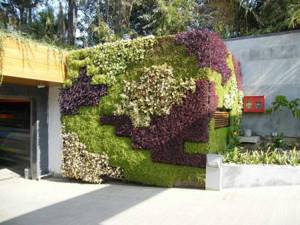
To create beautiful fences, screens, arches, and walls, you don’t need to purchase expensive material or hire construction workers. It is enough to find boards, pipes, pots that have not been used for a long time in the barn and think about their future placement.

Even the simplest version of vertical gardening can turn an ordinary vegetable garden into something like a Spanish, Italian, or Brazilian courtyard.
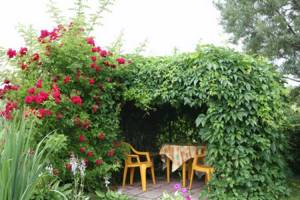
Typically, such a flowerbed requires virtually no maintenance. Plants for such decoration are particularly unpretentious.
Varieties of vertical gardening
The universal technique is used for various purposes, and summer residents do not require the help of a professional specialist.
Hedge
For this type of landscaping you will need a fence of any shape and material. A fence overgrown with vines will be a reliable obstacle to curious neighbors, sounds, and dust.
The most popular plants are maiden grapes, ivy, decorative beans and other fast-growing and unpretentious vines.

How to apply vertical gardening at your dacha.
The simplest method of vertical gardening is a design of vertically fixed flower pots.
You can use a similar design of a vertical flower bed both in the country house and on the balcony.
A simple design made from PVC pipes will allow you to create an impromptu flower garden on an open terrace or veranda.
Pots with flower seedlings are inserted into the holes of the pipes, and the ends of the pipes are closed with lids. The pipes are connected to each other with a strong cable.
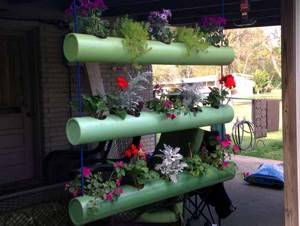
Use these unusual vertical gardening ideas not only to grow flowers, but also to grow herbs and lettuce.
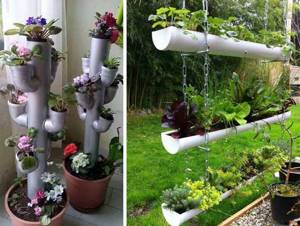
Vertical gardening of a fence will allow you to grow fresh leafy vegetables even in the complete absence of a garden plot. Your vertical garden can not only decorate the fence, but also become the fence itself.

Pergolas
Wooden pergolas will help create an unusual flowering corridor. They will look great in any decor style. The structures can be used as canopies, canopies, screens, enclosing an area or decorating walls.

Any climbing plants are suitable for decorating a pergola, but elegant roses or grapes will give them a special charm.
Felt pockets
This type of green composition is the most flexible and difficult to install (but it has its advantages). They look great on complex geometric walls.

- Living fence - the best ideas on what to make a hedge from at your summer cottage. Many photos of ready-made options with exclusive designs + instructions
- Trimming bushes - the basics of choosing the right plants and forming the right shapes, selecting tools (photo + video)
- Landscaping a site - basic principles and rules for creating a beautiful site with your own hands
Water can be supplied to them and an automatic irrigation system can be used. Since the plants are planted in a small volume of soil, they must be regularly fertilized with minerals.
It is important to install a special tank with a sensor. It is needed to control the density of fertilizer in the liquid. Landscaping in an apartment is not just a beautiful design, but also a favorable microclimate in the room.
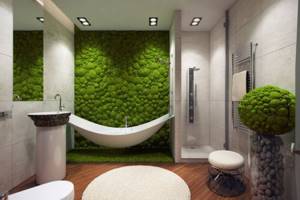
Trellis
Grilles, consisting of a strong frame and thin internal crossbars, can complement an arch or be a completely independent item for creating vertical gardening.

Note!
- How to make a hot smoked smokehouse - 75 photos of the best ideas and step-by-step instructions
- Molds for paving slabs - easy instructions on how to make them yourself (80 photo ideas)
- Feeder for chickens - ideas, description of construction and features of creating feeders from scrap materials
They will serve perfectly as a support for creating an inclined green wall, a fence separating neighboring properties, or decorating any building.
Any creeping or climbing plants are used as trellis decorations. And particularly pragmatic gardeners have adapted them for growing green peas, beans, and cucumbers.
Types of vertical gardening
There are several types of vertical gardening that have their own distinctive characteristics and are suitable for decorating certain spaces.
Using climbing plants
The most affordable method that is suitable for decorating different areas. You can make the design in the form of floating vines. You can use climbing plants to make hedges. To decorate a country house or cottage, you can use vertical landscaping on facades.
Using flowerpots
They are vessels with flowers that are attached to poles or independent structures. Flowerpots can be of various shapes: round, oval, square, etc. This type of landscaping is used to improve the interior of city streets, gardens and country houses. The use of flowerpots with flower arrangements is an ideal option for vertical gardening of balconies.
Vertical landscaping of the house facade

Vertical gardening in the living room
Living walls
It is a façade landscaping technology characterized by the presence of green plants along the entire length of the building wall. Used for decorating buildings. A metal frame is attached to the wall, then a frame made of plastic material is attached. A material resembling felt is placed in the frame, into which plant seeds are planted. After planting, the structure is provided with constant circulation of water so that the seeds germinate. An important condition is the presence of sufficient sunlight.
In addition to greening the external walls of buildings, vertical gardening is often used in the interior.
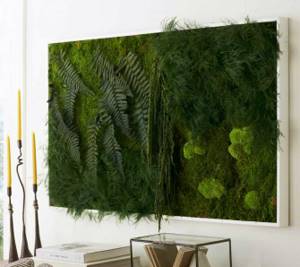
Vertical gardening in the living room interior
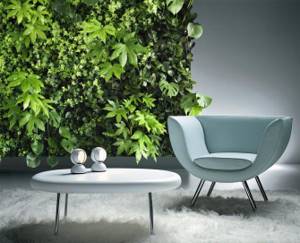
For this, several types of phytostructures are used:
- The most affordable option are structures consisting of hanging baskets, on the sides of which there are special slots. Various plants are planted in them. Together, the planted flowers form a ball shape. The internal cavity of the vessel is lined with a special material that helps retain moisture. The ideal option would be wool or coconut fibers, as well as unprocessed wood waste.
- Phytowall. The most difficult type of indoor landscaping. It is a curtain that includes a large number of pockets in which various ornamental plants are planted.
- Phytomodule. Another name is phyto-picture. The basis of the design is an ordinary picture frame. The size is selected individually. Also for manufacturing it is necessary to purchase a sheet of plywood, the dimensions of which will correspond to the dimensions of the frame, and wire mesh. This design for vertical gardening is quite simple to make. The frame must be turned face down. Then a wire mesh is attached to its base. A construction stapler is suitable for fastening. Moss and soil are placed on the mesh. Then it is secured with plywood. Then the plants are planted. It is recommended to start the process by planting large specimens. And only then complement the phytopicture with small details. Before placing the module on the surface in a horizontal position, it is necessary to water for two weeks so that the plants can take root in the soil. You can use a phytomodule with automatic watering.
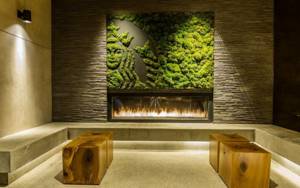
Vertical gardening above the fireplace

Vertical gardening in the kitchen
Hanging pots
Vertical gardening plants that don't require much soil can be placed in hanging pots and containers. If you have free time, they make entire hanging gardens that Semiramis herself could envy.
By the way, the landscaping in the apartment can also be diversified by a cascade of pots descending from the ceiling. This composition will look especially cozy above the dining table or in the living room.
To create this option, use containers and pots that have fastenings for ropes and chains. Begonias, petunias and other hanging plants will help you decorate containers beautifully.

Plants for vertical gardening
Climbing plants are a common type of plant for vertical gardening. Plants for vertical gardening are selected taking into account their ability to produce long shoots covered with leaves and flowers.
The most commonly used plant is vines.
For people who have just started developing vertical gardening, it is better to use unpretentious plants that do not require careful care: hops, Chinese lemongrass, wild grapes.

Veteran gardeners and flower growers grow with great interest roses that are difficult to care for and beautifully entwined with frames.

Vertical flower bed
Such flower beds are hung on tree branches, building walls, and fences. So they don't take up space at all.

A beautiful decoration for such a flower bed will be low flowers (hyacinths, dwarf marigolds, mosses, purslane) or creeping plants such as nasturtium.

A vertical flower bed (and more than one) can be made on the balcony, creating cozy green walls and filling the adjacent room with fresh air.
If you have a small unsown area, you can use pyramids, on each step of which there is a pot with a green miracle. Recently, similar structures have begun to be used as real beds. Strawberries, herbs, and medicinal plants will take root wonderfully in them.

At the same time, pots can be quickly changed depending on the mood or season. Therefore, such a flower bed will delight its owners with a lovely view all summer long.
Popular and interesting designs
Depending on the goals, various designs are used for non-standard landscaping. This includes arched structures, pergolas, all kinds of hedges, hanging elements and vertical flower beds.
Arches
The well-known arches will harmoniously form the transition from one area of the dacha to another. If you have free space, placing several structures in a row will create a kind of gallery. An interesting object located at the exit from the arched vault will help add harmony to the landscape design of the dacha. It could be a statue, an exotic bush or an original tree. For vertical gardening, climbing roses, clematis, honeysuckle or morning glory are suitable here. By placing three or four U-shaped models in a small area, you can create a picturesque corner that imitates the riot of wild nature. Most often, an arch for vertical gardening of a dacha is made of metal or wood; stone options are less common.
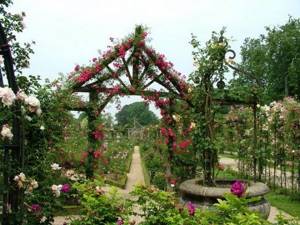
Advice! The dimensions of the structure should provide comfortable passage and stay under the arches. Care should be taken to ensure that climbing plants located on the arch do not cling to hair and clothing and do not block the path.
Properly selected dimensions will help to fulfill the conditions: the height must be at least 2.2 m, the width varies between 1.2-1.5 m, although wider options are allowed. If a single model is installed, a half-meter width of the side wall of the arch is provided so that climbing plants have a place to settle.

Pergolas
The idea of building pergolas originated in the Mediterranean. Initially, their purpose was purely practical and was to support the vine, as well as to facilitate the harvesting process.
The design consists of repeating sections in the form of pillars or arches connected by beams. Thanks to their simple architectural design, aesthetic appearance and practicality, pergolas have won the hearts of landscape design specialists and have firmly occupied their niche in the vertical gardening of summer cottages. A pergola entwined with grapes or other climbing plants can perform different functions:
- Use as a canopy provides a sealed top to provide protection from the sun's rays. It is installed as a separate object on the playground or parking lot, or adjacent to the main building of the dacha.
- A pergola-screen is optimal for vertical gardening, fencing off the area of the dacha from prying eyes or performing the task of zoning.
- The pergola over the garden path looks harmonious. Vertical landscaping will provide an imitation of a tunnel.
- For a house located in southern latitudes, a pergola in the form of a canopy will be a salvation from the heat.
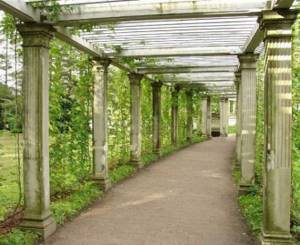
When installing a pergola, make sure the following conditions are met:
- harmony of styles between the lightweight structure and the main structure;
- correspondence between the size of the building and the total area of the dacha;
- Vertical gardening will over time create a significant load on the structure, so strength is an important point.
Hedges and obelisks
Hedges are widely used in vertical gardening. Their garden design takes various forms.
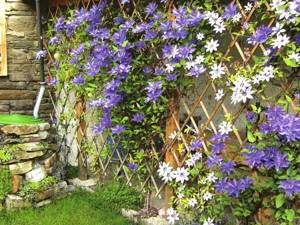
It can be:
- gratings;
- screens;
- trellises;
- poles connected by ropes or chains.
The idea of vertical gardening using trellises is quite popular. As a rule, this is a wooden structure, specially designed for decoration with climbing plants. In addition to wood, metal painted in olive, brown or white is used for manufacturing.

Vertical lattice landscaping harmoniously combines with arched structures. They can be fixed near the wall of a building, a fence or between pillars. A lattice installed between the pergola posts will help you cope with the task of fencing or zoning the space. Finding a structure near a fence can successfully disguise an unattractive place.
A colonnade of pillars connected by durable material in the form of chains or rope can create original vertical landscaping at your dacha. Climbing roses, clematis or grapes are suitable for decorating the design. This vertical gardening solution provides an interesting transition between individual areas of the dacha.
Obelisks for vines are another interesting landscape design idea for vertical gardening. To do this, you will need to create a cylindrical or pyramidal structure with a diameter of 0.4 to 0.8 m and a height of 1.5-3.0 m. Sweet peas, climbing aconite, princelings, or the same climbing roses are planted near it. The main thing is that the plant is not very large and heavy. Sometimes a dried tree is used as an obelisk if its location in the country house played a significant role in the landscape design.
Comment! To transform a tree into an obelisk with vertical gardening, the plants will need help securing with plastic mesh or cords.
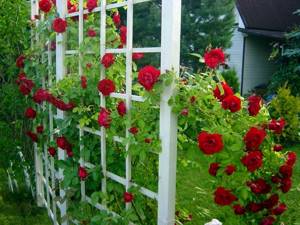
Hanging models
Another direction of vertical gardening is hanging container models. Flowerpots with hanging plants are ideal for decorating a terrace. This includes pelargonium, petunia, begonia and others.
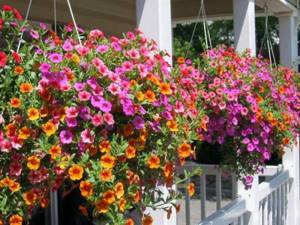
Boxes or containers fixed vertically will help to decorate the wall of a building or the fence of a dacha in an original way. Plants that are not demanding on soil quality and large amounts of moisture are planted in them.
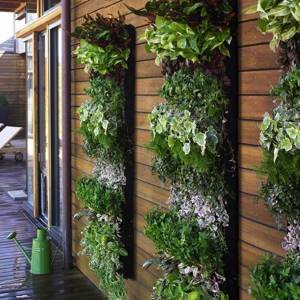
By sawing a plastic pipe in half, you can create another unconventional design for vertical gardening of a dacha. Several of these elements are attached between two poles or suspended on ropes, and holes are drilled from below to drain excess moisture. By planting fragrant and healthy herbs in them, you will combine decorative and practical functions in one model.
Hanging pockets fixed to a fence or wall of a building can be useful for landscaping a small area of a dacha. Compost is used as soil. If the fabric does not allow moisture to pass through well enough, drainage holes are made at the bottom. A tray is installed to collect excess liquid. As a rule, aromatic greens are planted in them.
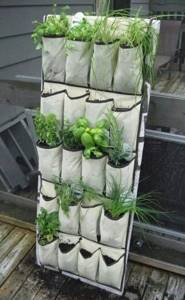
Vertical gardening of an apartment
Interior landscaping is becoming an increasingly common way to create a truly comfortable space. And if earlier the role of such decor was played by flowers on window sills, stands or bedside tables, today the interior walls of houses and apartments are decorated with special phytomodules for vertical gardening.

You can make them yourself using a frame, fine mesh and moss, but it is better to purchase a vertical green miracle in a store. Specialized companies even create entire phyto-pictures that will become the highlight of the interior and a source of pride for the owners.

However, before purchasing such modules, you need to evaluate your gardening aspirations. Caring for such a masterpiece can be too difficult.
If the skills are clearly not enough, then a green wall can be created using a rack with more familiar pots.
Photos of vertical gardening will demonstrate the most popular options for creating green decor for a garden, balcony or interior.

Ways to use vertical gardening
Option #1 – greening buildings
Vertical gardening of houses is especially popular in the UK, where already cozy cottages take on an even more attractive appearance when one of the walls, and often the entire house, is covered with a cascade of green ivy or wild grapes. These varieties of vines are most suitable for vertical gardening of buildings in our climate. The advantage of this type of green home decor is that under the greenery you can hide the shortcomings of the building.
Option #2 – creating a microclimate
If you use vertical gardening on a large scale, and not just as a decorative element, with its help it is really possible to regulate the microclimate on the site during the warm season. Arches, galleries, gazebos, verandas, entwined with climbing plants, form shady corners where you can hide from the summer heat and scorching sun. Thus, these are not only beautiful decorative elements, but also functional structures.
A decorative wall, on which there are many ampelous petunias and fuchsias in flowerpots, can become an element of garden zoning and an excellent decorative element.
The thick green curtain also reduces noise levels, making it so pleasant to be in its cozy shade. Areas of soil under vertical green structures are always more moist, moisture from the shade of the ground evaporates more slowly, as a result, the air in the area in the summer heat will be more humid, with less dust.
You can also decorate a fence with weaving plants, read about this:
Option #3 – zoning
Vertical gardening of a dacha can be successfully used to divide the garden into zones. For example, a recreation area can be separated from a business area by a picturesque hedge, which can have many forms if you show your imagination.
To help gardeners today, there are vertical gardening structures that are created specifically as decorative elements for climbing plants. Metal and plastic meshes, wooden gratings, elegant pergolas, screens - using one or two elements in the garden, you can already create bright, expressive images. Such a picturesque wall of flowers and greenery will add special beauty to the garden, and will create coziness and comfortable conditions for the owners.
Photo of vertical gardening
Vertical gardening scheme.
For vertical gardening, two main approaches are used - using drip irrigation supported by a pump and the second option using regular open watering.
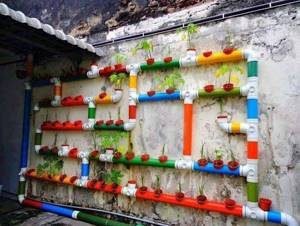
Drip irrigation using plastic bottles.
In the upper and lower part of the frame with bottles there are horizontal containers with water and nutrients. Using a pump with a timer, water rises into the upper container, from which water drips into the plastic bottles in which the plants are located.

Open watering.
With open watering, a sufficiently large hole is made in the pipe and the plants are watered in the usual way. Vertical gardening is a unique (or, to some, surprising) way of growing your favorite plants. For some it is an interesting experiment, for others it is a necessary necessity. But the best thing about this is that you can use leftover materials such as plastic bottles or scraps of PVC pipes for a vertical garden. In addition, using the principles of vertical gardening, you can add greenery even in an ordinary apartment in winter.
